#2.3L High Performance Package
Explore tagged Tumblr posts
Photo

New Post has been published on https://fastmusclecar.com/2025-ford-mustang-review-a-modern-icon-reimagined/best-muscle-cars/
2025 Ford Mustang Review: A Modern Icon Reimagined
The 2025 Ford Mustang continues its legacy as America’s quintessential pony car, blending modern performance, cutting-edge technology, and unmistakable style. As one of the most anticipated models in recent years, the 2025 Mustang aims to balance its heritage with innovation, catering to both traditionalists and newcomers alike.
Exterior Design: Evolution Meets Aggression
The 2025 Mustang retains its iconic silhouette but features sharper lines and a more aggressive stance. The updated front fascia showcases slimmer LED headlights and a redesigned grille that hints at its performance capabilities. New aerodynamic enhancements, such as an active front splitter and rear spoiler, improve both aesthetics and functionality. Buyers can choose from an array of bold colors, including the new Electric Blue and Heritage Green, alongside customizable stripe packages for added flair.
Interior: Tech-Forward Comfort
Inside, the Mustang’s cabin feels like a blend of a fighter jet and a luxury car. A large, fully digital instrument cluster flows seamlessly into a 15.5-inch touchscreen running the latest SYNC 5 infotainment system. The interior materials have been upgraded, with premium leather, brushed aluminum accents, and soft-touch surfaces throughout.
Advanced technology takes center stage, including over-the-air updates, wireless smartphone integration, and a customizable ambient lighting system. Ford’s new “Driver Focus” mode uses AI to adjust settings like seat position, climate control, and drive modes based on individual preferences.
Performance: Power and Precision
Under the hood, the 2025 Mustang offers multiple powertrains to suit a variety of driving styles:
2.3L EcoBoost Turbocharged I4: Delivering 330 horsepower and improved fuel efficiency, this entry-level engine is perfect for enthusiasts seeking a balance between performance and economy.
5.0L V8 Coyote: A revamped version of Ford’s legendary V8 now produces 480 horsepower, with enhanced torque for quicker acceleration.
Hybrid V8 Option: For the first time, Ford introduces a hybrid V8, combining the roar of a classic engine with the efficiency of electric assist, pushing the total output to over 550 horsepower.
Mustang Dark Horse: A track-focused variant featuring advanced aerodynamics, a tuned suspension, and a high-output V8 delivering 600 horsepower.
All models come with a choice of a 6-speed manual transmission or a 10-speed automatic, ensuring an engaging driving experience for purists and convenience seekers alike.
Driving Dynamics: The Thrill of the Ride
The 2025 Mustang benefits from a reworked chassis and suspension, providing improved handling and ride comfort. The optional MagneRide damping system adapts to road conditions in real-time, making sharp corners and uneven surfaces a breeze. Enhanced steering precision and new performance tires further elevate the Mustang’s driving dynamics.
Safety and Driver Assistance
Ford has equipped the 2025 Mustang with its latest Co-Pilot360 suite of driver-assistance technologies, including:
Adaptive Cruise Control with Stop-and-Go
Lane-Keeping Assist
Blind Spot Monitoring with Cross-Traffic Alert
Active Park Assist
Additionally, the Mustang’s advanced crash-avoidance systems and improved structural design ensure a high level of safety.
Pricing and Trim Levels
The 2025 Ford Mustang is available in multiple trims, catering to a wide range of budgets and preferences:
Base EcoBoost: Starting at $32,000
GT: Starting at $42,000
Hybrid V8: Starting at $50,000
Dark Horse: Starting at $65,000
Optional packages include the Premium Tech Package, Track Pack, and Heritage Appearance Package, allowing buyers to further personalize their Mustang.
Final Thoughts: A Mustang for the Future
The 2025 Ford Mustang successfully bridges the gap between tradition and innovation. With its blend of iconic design, modern technology, and versatile performance, it appeals to a broad audience while staying true to its roots. Whether you’re a long-time Mustang enthusiast or a first-time buyer, the 2025 Mustang offers something special for everyone. It’s not just a car; it’s a statement—a true embodiment of Ford’s commitment to performance and style.
0 notes
Text
Jeep Wrangler Sport S and Mustang 2.3L Convertible: Two Fours for Summer Fun
Words and Photos By Michael Hozjan
No I’m not talking about cases of beer. I’m referring to the number of cylinders found under the hood of two American icons in the automotive landscape – the Jeep Wrangler and Mustang. Don’t scoff, four cylinders have been making a huge come back in recent years and no, these are not your grand dad’s four cylinders. Both the Jeep and the Mustang rely on turbocharging to get the extra oomph when needed all while delivering below average thirst numbers compared to their V6 and V8 counterparts. Let’s face it do we really need all that horsepower all the time and isn’t it nice to save some bucks at the pump.
Jeep Wrangler Sport: Back to its roots
“There’s something amiss here.” I tell myself as the engine comes to life. I hit the off button and check for the glow plug light, there isn’t one. For some reason the engine doesn’t sound the same, and yet there’s something eerily familiar about the sound. I mistakenly expected the Wrangler to be diesel powered, which it was not. The diesel mill is offered in the Gladiator that I was due to drive, but at a later date. Blame it on old age or just on my eagerness to get behind the wheel of one of my favorite rides.
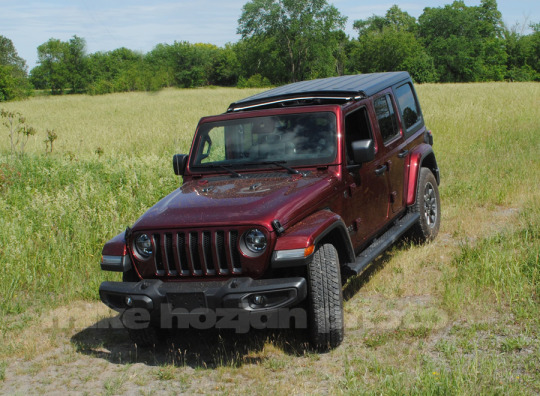
Well one thing lead to another and another and before I knew it, it was several days later that I popped the hood to gaze upon the turbocharged inline 2.0L four cylinder. THAT’S what the sound was… somehow, the engineers at Jeep have managed to get the sound of the old familiar World War II era four cylinder Jeep into this modern, 80th anniversary edition Wrangler…or maybe it’s just me. One thing is certain, it doesn’t sound like the Wrangler I’ve been accustomed to.
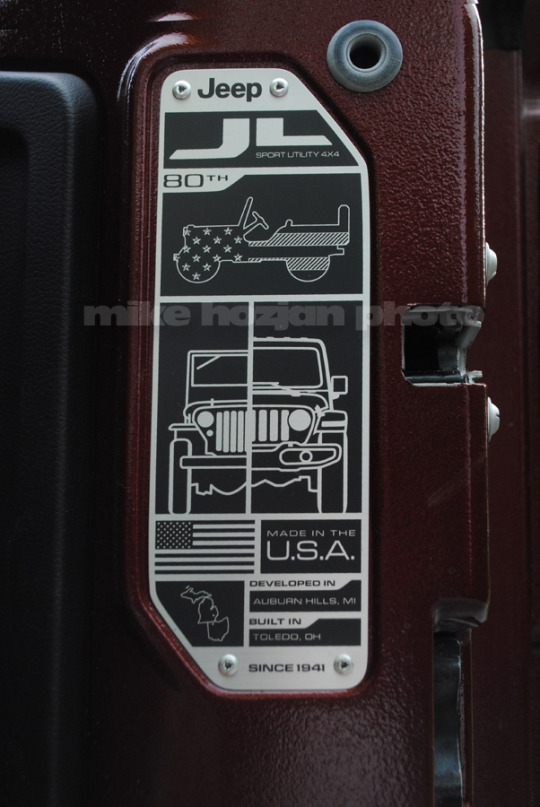
Maybe it’s just coincidence, maybe it’s good corporate planning, with Jeep’s closest off-road capable rival, the Ford Bronco making its debut this year, Jeep has stepped up the ante, not only have they launched the Wrangler Xtreme Recon equipped with the first ever 35-inch rubber straight out of the factory, but are also offering a slew of powerplants to make any competitor nervous: beginning with this week’s tester, there’s the 2.0 L turbocharged four cylinder mated to the 8-speed TorqueFlite automatic, the trusty old 285 horsepower Pentastar 3.6L V6s remain and come with either a manual or automatic trans, there’s also a mild hybrid version mated to the 3.6L tagged the eTorque, a 3.0L EcoDiesel V6 with 442 lb-ft of torque and 260 horses and for the first time in four decades, the Wrangler gets a V8. Available exclusively (dare I say for the time being) in the Rubicon 392 trim, the 6.4L throws out 470 horses and the like amount of torque through the eight-speed TorqueFlite automatic transmission and Selec-Trac full-time active transfer case. It blasts the Rubicon 392 to 100 km/h in less than five seconds making it the quickest Wrangler in history!

Well it appears the Jeep has come full circle with their mills, reverting back to four cylinder power to move their off roaders about. But don’t think for a minute that these are the old WWII flatheads. No sir, and not one but two count them, two four cylinders are offered. Aside from my Snazzyberry Pearl colored 2.0L turbocharged tester which pumps out 270 horses and 295 lb-ft of torque, capable of towing 2,000 lbs (907 kilos), that’s 35 more lb-ft of torque than its V6 counterpart, there’s also an electrified four cylinder that adds an electric motor. The plug in hybrid 4xe delivers 375 horses! Stay tuned for more on this one.
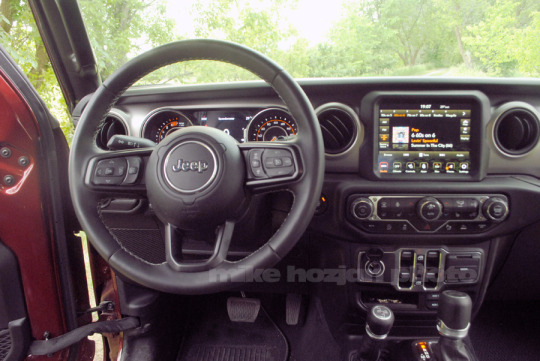
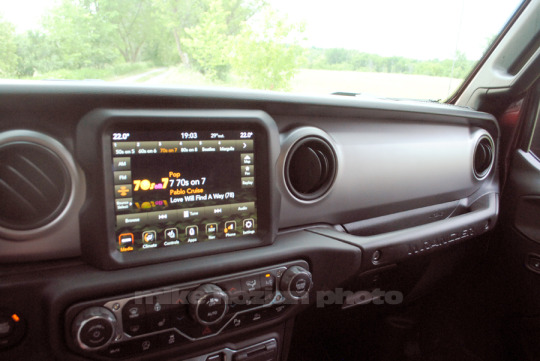
Above and below: There’s nothing missing in the four that you wouldn’t find in the six.
If you’re a regular reader of my posts you’ll know that I do NOT check performance numbers or price tags before I get a feel for what the vehicle feels like. Does it feel like 300 horses, does it feel like 400 lb-ft of torque? I tend to reserve looking at the stats until after my first, second and third impression. That said, despite having 270 horses, it still seemed a bit anemic from my previous Wrangler encounters (with the V6). There’s a noticeable difference at half throttle when leaving a red light or stop sign, but that quickly disappears as you build up speed. Punch the go pedal however to wake up the turbo boost and grab on to the steering wheel. The torque kicks in and bites the tarmac like a banshee. Suddenly Jeeps decision to go with this combo makes perfect sense.

On the highway the four delivers smooth, linear power and actually feels better mated to the 8-speed automatic than the six. Passing semis or climbing grades isn’t a problem and while I didn’t get the chance to go off-roading I suspect that the added torque would be able to let this Wrangler do some serious climbing prowess without hesitation.

Of course one of the other main attributes is that the Wrangler can shed its top when the weather turns warm. With two tops available it still remains the only convertible SUV in the market.
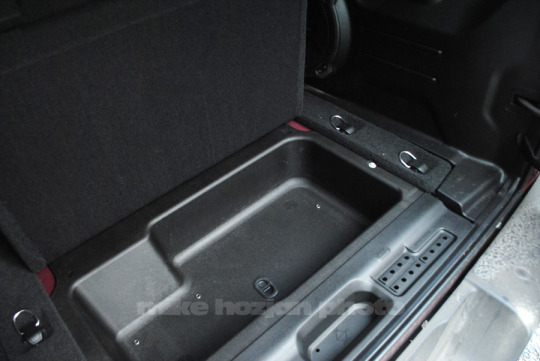
Above: A hidden cubby hole under the trunk floor comes in handy
One of the Wrangler’s Achilles’ heals has always been it’s thirst for fuel. My best has usually been around 12L/100 kms even when feathering my foot. Well the 2.0L netted me a 9.75L/100 average, on top of which a $200 saving over the automatic trannied V6 makes getting into a Wrangler a lot easier. The Sport S starts at $45,465, my fully loaded tester came in at a substantial premium, which leads me to want to see this mill in the 2-door Wrangler variant with a manual transmission. Now that would truly be full circle. If you’ve always wanted a Wrangler but weren’t crazy about their fuel consumption Jeep has just given you several reasons why you should reconsider.
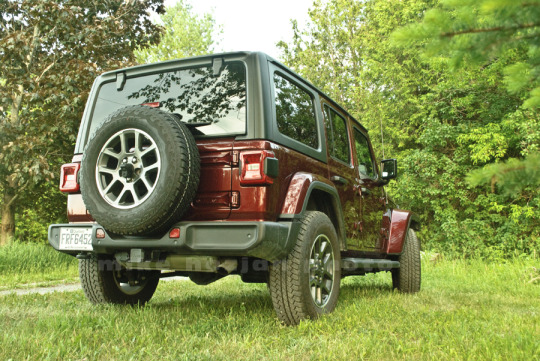
Price as tested: $62,030 *
*Includes excise tax and destination fees
Mustang 2.3L Convertible: Is this the best Mustang ever?
It’s a balmy July afternoon, the kind we wait all year long for and fantasize about from December through to March. I’m in the left lane of the 401 heading west, passing semi after semi. The sun is beaming down on me and I get to thinking how nice this thing would be for a cross-country run. Indeed it doesn’t get much better than this. There are so many semis it reminds me of the rocking chair scene in The Bandit, only I’m not driving a T-top black Firebird with a roaring V8 and Sheriff Buford T Justice chasing me, but a drop top Antimatter Blue (yes that’s the hue) Mustang with a turbocharged 2.3L four cylinder.
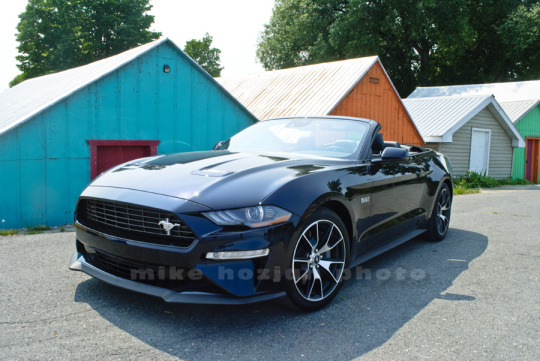
For decades Ford has been grappling with the notion of having both a high performance Mustang and an economy Mustang, and yes when it first debuted there were trims that encompassed both. But over the years that concept got lost with muscle cars taking the limelight. It wasn’t until the gas crisis of ’73 that the economy car resurrected itself in the Mustang II, but in the process lost the muscle slice of the pie.
Well guess what, the 2.3L fits both bills easily. Yes diehard muscle heads may pooh pooh the thought of another four cylinder in a Mustang but they have no idea what they’re missing out on.
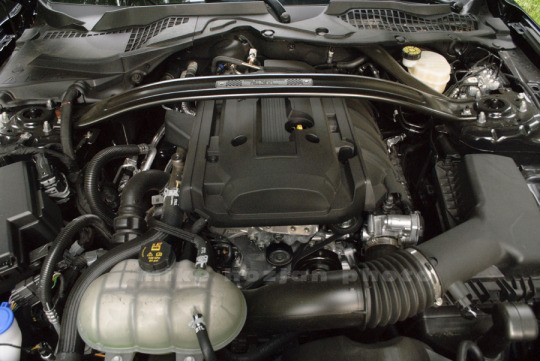
Pillaged from the darling all-wheel-drive Ford, the Focus RS, the 2.3L mill has been turned longitudinally to fit into the pony car. Although Ford has given the Mustang a larger twin scroll turbo, there are 18 fewer horses pulling the pony car over the RS. Torque however has been retained.
With 310 horses and 350 lb-ft of torque on tap mated to an optional 10-speed automatic my tester galloped along without so much as missing a breadth. Thankfully Ford has retained the 6-speed manual. My unofficial timing showed zero to a hundred kilometers shot in at 4.6 seconds! I have to say that as sweet as the four cylinder is, the exhaust note just tries to hard and gets annoying after a while. It’s like look at me, look at me. Oh shut up! Thankfully there is a shut off switch.

My ‘stang came with the High Performance Package, a $6,500 option inherited from the Mustang GT, which meant stickier 19” Pirelli rubber over the base car’s 17” units, larger brake rotors with four piston calipers, stiffer springs, a beefier rear sway bar, strut tower brace, a larger rad, a 3.55:1 limited slip diff. In other words, all the right stuff to make this a serious tourer.

Above and below: Top up or top down the Mustang looks great. Front spoiler is part of the High Performance Package.
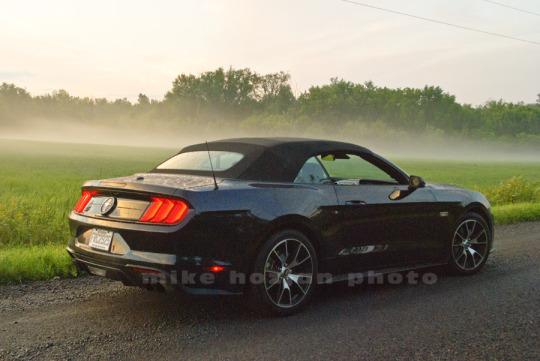
Another plus for the four-cylinder argument is better balanced shedding 147kilos (auto trans) off its front axle. The result is a crisper handling ride with a nominal amount of body roll, less nosedive under hard braking. Switching driving modes from Normal to Sport mode for attacking the lakeside twisties shows the car’s true potential with the engine’s responsiveness hitting the sweet spot over 2,500 rpm and the fun factor sans V8.
This would make an interesting track car.

Inside you get all the usual fan fare of goodies including cooling and heated power leather seats. The hi-po package adds an oil pressure and turbo boost gauge and engine spun aluminum instrument panel. Fit and finish is spot on with comfortable buckets making the drive that much more enjoyable.
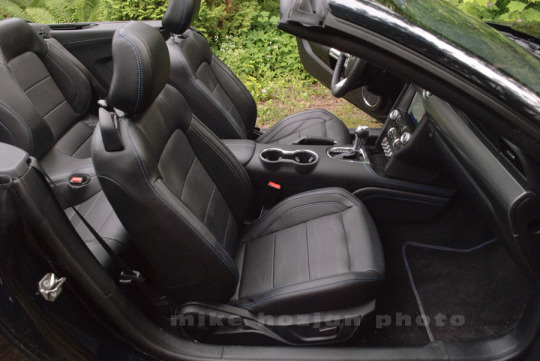
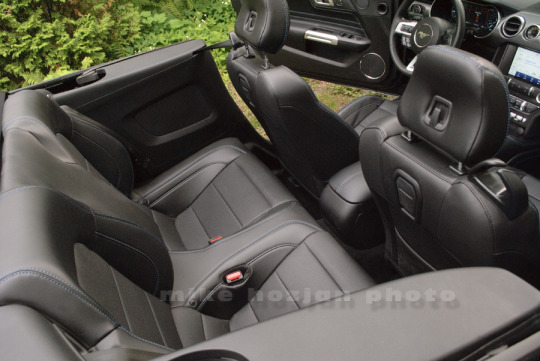
Above: Despite what it looks like my 6’ frame spent several hours back there in a friend’s convert for a three-hour trip to the Syracuse Nationals a few years back without a single complaint.
Like the Jeep the Mustang doesn’t come cheap. While the base price is a very reasonable $43,370, my tester’s option list added another $11,800 to the price tag. Stepping up to the $6,500 high performance package is a no brainer, especially if you’re a serious driver, but while the 10-speed is perfectly matched to the engine and responds wonderfully to throttle inputs I’d go with the 6-speed manual and trim $1,750 off the tag. Other options included $1,000 AM/FM/CD/HD radio, $2,300 for adaptive cruise, voice activated touch screen navigation and the Ford Safe & Smart package.
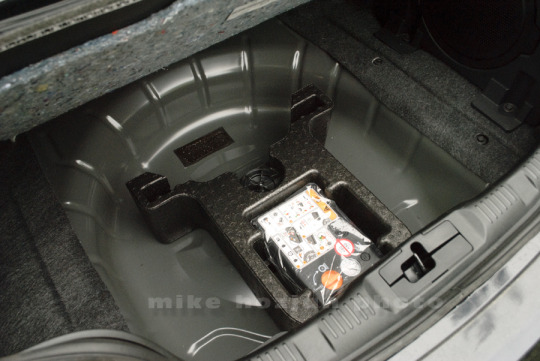
In a move I just don’t understand is the spare tire/wheel has been relegated to option status! In its place is a compressor - just the ticket for a bent rim, blow out or flat in the middle of nowhere on a dark rainy night. Come on Ford!
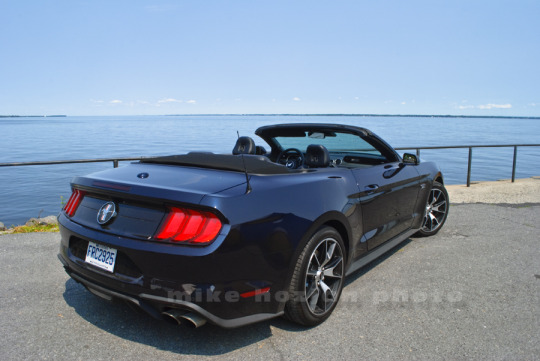
Yes the Mustang buyer has a number of trims and powerplants to opt for all the way to the 100 grand Shelby GT500 but really, wouldn’t you rather have a car that hits all the right fun buttons without breaking the bank while still passing a gas station or two ( I averaged 10.7L/100 km). Oh and let’s not forget the savings on the insurance premium on the four cylinder So shrug the V8 monkey off your back and hit the road in a four.
Price as tested: $56,970*
*Includes destination charges
#jeep#jeepwrangler#suv#four cylinder#2.0l#turbocharged#pentastar#mustang#convertible#pony car#muscle car#2.3l#high performance#mustang gt#car insurance
1 note
·
View note
Text
What is included with the 2020 Ford Expedition’s FX4 Off-Road Package?
Appearance and performance features of the 2020 Ford Expedition Limited FX4 Off-Road Package
Never one to be content at the top of the pack, the Ford model line is always looking for ways to improve its vehicles in the ways that its drivers cherish the most. For a good majority of Expedition owners, this includes a healthy dosage of off-road charm, brought on in high supply with the recent unveiling of its FX4 Off-Road Package, available exclusively on its Limited trim.
With stellar new design cues and a muscular, trail-ready suspension, the 2020 Ford Expedition Limited FX4 Off-Road Package is one of the best that money can buy. Come check it out with Sherwood Ford!
2020 Ford Expedition FX4 Off-Road Package New Exterior Design
Athleticism is the name of the game for the FX4 package, which includes new 32-inch all-terrain tires, 18-inch cast-aluminum rims (painted in a confident shade of metallic gray), and off-road tuned shocks. You’ll also find seven underbody skid plates included with this package, intended to protect intercoolers, steering gear, your engine, transmission, transfer case and more.
For a nice little accent to the Expedition’s new appearance, it also features a chrome-plated running board complete with angular step bars. All of these combine to create a machine that’s both a looker and a performer all the same.
2020 Ford Expedition FX4 Off-Road Package Performance Upgrades
You won’t just look better with the Expedition’s FX4 package equipped, you’ll also handle better. With its heavy-duty trailer package in the mix, the 2020 Expedition Limited FX4 can handle a maximum tow rating of 9,200 pounds; that’s best in class. Even still, an electronic limited-slip differential, heavy-duty engine radiator and Terrain Management System

are all yours, putting more off-road capability in your hands.
Read More: Highlights of the Ford 2.3L ROUSH Performance Pac
Get the FX4 Off-Road Package for the 2020 Ford Expedition Limited at Sherwood Ford in Edmonton AB
Both standard and extended-length (under MAX designation) Expedition models can get the FX4 off-road package installed, and if you’d like it for your vehicle, be sure to contact Sherwood Ford as soon as you can. Our service technicians are always happy to help!
The post What is included with the 2020 Ford Expedition’s FX4 Off-Road Package? appeared first on Sherwood Ford.
#1 Ford Daily | Đại lý – Showroom ủy quyền Ford Việt Nam 2019 Ford Daily là showroom, đại lý Ford lớn nhất Việt Nam: Chuyên phân phối xe ô tô FORD như: EcoSport ✅ Everest ✅ Explorer ✅ Focus ✅ Ranger… [email protected] 6A Đường Trần Hưng Đạo, Phường Phạm Ngũ Lão, Quận 1, Hồ Chí Minh 711240 0901333373 https://forddaily.com/ https://forddaily.com/xe/ https://forddaily.com/dai-ly/ https://forddaily.com/bang-gia/ https://forddaily.com/tra-gop/ #forddaily #dailyfordhcm #fordshowroomhcm https://www.google.com/maps/place/Ford+Daily/@10.7693359,106.696211,15z/data=!4m5!3m4!1s0x0:0x1f188a05d927f4ff!8m2!3d10.7693359!4d106.696211
0 notes
Photo

Ford Mustang 2020 High Performance Package 2.3L #fordmustang #fordmustangs #fordmustang2020 #fordmustanghpp https://www.instagram.com/p/B5p2dqNlEKW/?igshid=1kqpk4sce149c
0 notes
Text

New-gen Ford Performance Focus ST Brings Most Capable Model To Date, With New 2.3L Turbocharged Powertrain Including 7-speed Paddleshift Auto For The First Time
Ford Performance Focus ST will debut in Australia and New Zealand in Q1 2020 with new-generation model offering a choice of automatic and manual models for the first time, taking full advantage of the tech and innovation of new-generation Focus’ C2 platform
Focus ST brings improved cabin space, 206kW/420Nm turbocharged powertrain, selectable Drive Modes, with an electronic Limited-Slip Differential (eLSD), Launch Control, Performance shift-lights, and fully-independent rear with Adaptive Suspension
SYNC 3 as standard brings Apple CarPlay and Android Auto smartphone compatibility, with wireless smartphone charging, built-in sat-nav, B&O PLAY 10-speaker premium audio, 180-degree rear-view camera, with tech including AEB with Pedestrian Detection
Focus ST comes with a five-year/unlimited kilometre factory warranty, as well as Ford Service Benefits, which includes Service Loan Car Program, Service Price Promise and SYNC 3 sat-nav mapping updates to eligible customers at participating dealerships
MELBOURNE, Australia, September 10, 2019 – The new-generation Ford Focus ST, developed under the leadership of Ford Performance, brings Australian enthusiasts the most advanced, capable Focus ST to date with more power, technology and choice. Based on the new-generation Focus’ C2 platform, the Focus ST brings an automatic variant for the first time, as well as the traditional enthusiast-focussed six-speed manual with rev-matching. In addition to expanded Selectable Drive Modes, there’s new technology including Continuously Controlled Damping (CCD), an electronic Limited Slip Differential (eLSD), and 2.3L turbocharged engine. “The Focus ST joins the Fiesta ST for 2020, offering a full suite of Ford Performance hot hatches for local enthusiasts,” said Kay Hart, President and CEO, Ford Australia and New Zealand. “Both bring new technology, with the Focus ST building on the innovation and tech leadership of the new-generation Focus, delivering a highly capable and livable performance hatch.” The Focus ST will be fully-imported from Germany, and will be on sale in Australia in 2020 with an MLP of $44,6901 for the 6-speed manual. A 7-speed paddleshift automatic is offered as a no-cost-option, with the ST taking the advanced C2 platform of the new Focus, introduced to Australia in late 2018, as a foundation to offer greater cabin space, cargo capacity as well as dynamic capability based upon a platform that delivers a 20 percent increase in torsional rigidity over the outgoing model. “Intelligent technologies like eLSD and CCD make our new-generation Focus ST the most ‘Jekyll and Hyde’ yet, able to switch from refined tourer to focussed performance car at the push of a button,” said Leo Roeks, Ford Performance director, Europe. “We’ve incorporated learnings from programs including our Ford GT supercar and the acclaimed Focus RS to develop a mid-size performance car with a degree of flexibility that’s unique in its segment.”
Focus ST: Looks that skill The Focus ST’s features both inside and out are designed to showcase its performance intent from any angle, building on the new-generation Focus’ core elements to deliver a Ford Performance optimised package. Immediately apparent, an aggressive stance is achieved with 19-inch machined alloy wheels, fitted with 235/35 Michelin Pilot Sport 4S tyres, as standard, with suspension that lowers ride height by 10mm over the standard Focus model. The Focus ST’s larger front and rear brake components are clearly visible, standing out with red brake calipers that clamp larger 330mm front and 302mm rear ventilated discs. A new electronic brake booster improves brake pedal feel, while braking performance was verified using the same demanding test procedures as the Ford GT supercar, and saw almost four-times the fade resistance performance of the previous generation Focus ST in testing. The Focus ST also boasts a honeycomb front grille, with LED headlight and taillights featuring LED Daytime Running Lights and for a signature look, with unique front and rear bumpers incorporating LED fog lamps and sculpted side-skirts producing a muscular look. An integrated spoiler caps off the major exterior changes on the ST’s hatch. Details include dual chrome exhaust tips, rear privacy glass as well as heated power-folding exterior mirrors with puddle lamps. There’s also unique ST badging in the front grille and rear hatch, exterior colour options chosen to emphasise the Focus ST’s dynamic styling including exclusive Ford Performance Blue and Orange Fury, alongside Frozen White, Magnetic (grey), Race Red, Ruby Red and Shadow Black2. The attention to detail continues inside the Focus ST. The heated Recaro sports seats are trimmed in leather and suede, with larger bolsters for improved lateral support during cornering, and feature ST logos, with lumbar support on the driver’s seat. Interior space is improved for the new-generation Focus ST, thanks to a 53mm increase in wheelbase, with greater occupant space in both front and second rows for greater comfort and convenience. Ford Performance instrumentation is standard, as are aluminium pedals that are matched to a chrome gear-lever for the six-speed manual, while the automatic Focus ST takes advantage of the new-generation e-shifter, which liberates space while enabling a cleaner console look. An electronic park brake also enhances space and interior sophistication for either transmission choice, while a flat-bottom heated ST steering wheel, wrapped in perforated leather, houses audio and SYNC 3 controls while delivering a premium feel and engagement for the driver.
Focus ST: Connectivity, technology and safety SYNC 33 as standard is another feature that brings livability and technology to the Focus ST. This includes a high-definition 8.0-inch touchscreen display, which includes Apple CarPlay and Android Auto smartphone capability4. Functions, including Siri, can be accessed via the steering-wheel mounted voice activation controls, with capabilities including voice-activated text messaging. In addition, the Focus ST’s standard built-in sat-nav can also be accessed by voice-command, with the system specially engineered to comprehend Australian accents. The Focus ST also features wireless smartphone charging as standard, with technology including keyless entry and push-button engine start, ambient LED lighting and dual-zone climate control. A five-star ANCAP rating was awarded to the new-generation Focus line-up in 2019, with the standardisation of the Driver Assist Technology (DAT)5 praised by ANCAP CEO James Goodwin. The Focus ST includes a full suite of safety and DAT as standard, including:
Autonomous Emergency Braking (AEB) with Cyclist and Pedestrian Detectioniv
Blind Spot Information System (BLIS) with Cross Traffic Alert
Lane Departure Warning
Lane Keep Assist
Adaptive Cruise Control (ACC)
Hill Launch Assist
180-degree full-colour, high-definition rear-view camera
Dynamic Stability Control
Driver, Driver’s side, Passenger Side and full curtain airbags
Auto high-beam headlights
LED Daytime Running Lights
Focus ST: Focus RS-developed powertrain The new all-aluminium 2.3-litre, turbocharged powertrain is the most potent ever offered in a Focus ST. Using advanced turbocharging technology to deliver 206kW6of power at 5,500 rpm – an increase of 22kW over the outgoing Focus ST – and a significant jump in torque, from 360Nm previously to 420Nmv , it is also the most free-revving Focus ST engine ever. Engine response is enhanced using a low-inertia twin-scroll turbocharger, which scavenges exhaust gas energy more effectively using separated channels to minimise interference between gas pulses. An electronically actuated waste-gate allows closer control of boost pressures for optimised engine performance. In addition, a unique exhaust system that reduces back pressure, bespoke air intake system and optimised intercooler further improve breathing. Innovative anti-lag technology developed for the Ford GT supercar and F-150 Raptor pick-up is introduced to the Focus ST, for immediate power delivery in Sport and Track Drive Modes. Anti‑lag keeps the throttle open when the driver lifts off the accelerator pedal, alleviating the reversal of air flow from the turbocharger to maintain compressor wheel speed and enabling boost pressure to build faster on demand. The Focus ST’s six-speed manual transmission enables more urgent gear-changes and provides a sportier feel with a shift-throw reduction of 7 percent compared with the standard all-new Focus. Ford’s rev-matching technology that debuted on the new Ford Mustang is standard for manual models. Delivering smoother, faster downshifts, the technology is accompanied by a shift indicator light, and uses the engine’s electronic control system to briefly ‘blip’ the throttle as the driver engages a lower gear – matching the engine rotation speed to that of the gear that is being selected. Rev-matching enables less-experienced performance drivers to benefit from the seamless, momentum-maintaining gearshifts delivered by the heel-and-toe driving technique. A new seven-speed paddleshift automatic will complement the rewarding, engaging and sporty 2.3-litre engine’s driving experience. Adaptive Shift Scheduling assesses individual driving styles to optimise gearshift timings, and is enhanced to offer more flexibility and the ability to differentiate between road and track use. Drivers can also select gears manually using steering wheel-mounted paddle-shifters.
Selectable Drive Modes: Focus ST’s smart chassis Building on accomplished Ford Focus’ driving dynamics, the new-generation Focus ST was developed to blend B-road fun-to-drive, legitimate track-day performance, and everyday usability. “Our target was to deliver an new-generation Focus ST that is as effortless to drive day-to-day as the rest of the Focus line-up,” Roeks said. “The model’s comprehensive range of technologies means customers gain exhilarating ST performance without sacrifice.” This flexibility and capability is accessed via Selectable Drive Modes that optimise the Focus ST’s capabilities for road (or track) conditions ahead. Slippery, Normal, Sport and Track Drive Modes adjust the eLSD, CCD, EPAS, throttle mapping, automatic transmission shift scheduling, electronic stability control (ESC), electronic sound enhancement (ESE) and climate settings to suit the driving scenario. A dedicated “Sport” button on the flat-bottomed steering wheel gives direct access to Sport mode, and an additional “Mode” button allows drivers to quickly scroll through the Drive Mode options. “Selecting Track mode instantly introduces higher steering efforts for more feedback; tunes the throttle to be more aggressive; instructs the eLSD to deliver maximum traction; and gives drivers more leeway within the ESC system,” Roeks said. “Drivers can have full confidence in the Focus ST’s ability to deliver on the track.” The Focus ST’s chassis brings a unique fully-independent rear suspension configuration that helps optimise the vehicle’s responses to driver inputs without sacrificing comfort. The agile and energetic character of the standard Focus is retained using the original spring specifications, with damping stiffness increased up to 20 percent at the front and 13 percent at the rear, and ride height reduced by 10mm, to improve road-holding and response in performance driving scenarios. The chassis upgrades also include Ford’s sophisticated Continuously Controlled Damper (CCD) technology for the first time on a Focus in Australia. The system monitors suspension, body, steering and braking inputs every 2 milliseconds to adjust damping responses for outstanding ride quality and driving dynamics. Also improving capability is the eLSD. The Borg Warner-developed technology is faster to deploy and offers greater precision than a traditional mechanical LSD. The system can pre-emptively adjust torque distribution using inputs from powertrain and vehicle dynamics sensors, rather than responding to wheelspin as it occurs, and can apply differential locking gradually for fine-tuning performance. The all-new Focus ST also takes Ford’s fastest-steering-response crown from the acclaimed Fiesta ST. The electric power-assisted steering (EPAS) system is 15 percent faster than the standard Focus, requiring just two turns lock-to-lock. Class-leading connected feel is supported by unique steering knuckle geometry, with a rod attachment point 9mm further forward and 6.5mm higher than the standard Focus for sharper responses. New Steering Torque Disturbance Reduction software for EPAS also helps reduce torque steer, making it even easier to deploy with precision the Focus ST’s power and torque. The new-generation Focus ST will arrive in Australian showrooms in Q1, 2020.
MY2020 Ford Focus ST Pricing Recommended Manufacturer List Price (MLP)i for Ford Focus ST and available options:
Ford Performance Focus ST MLPi ST five-door hatch, 2.3L turbo, 6-speed Manual $44,690 ST five-door hatch, 2.3L turbo, 7-speed Automatic $44,690
Ford Performance Focus ST Options MLPi Prestige Paint $650 Panoramic sunroof (fully opening) $2500
2020 Ford Focus ST Info and Prices New-gen Ford Performance Focus ST Brings Most Capable Model To Date, With New 2.3L Turbocharged Powertrain Including 7-speed Paddleshift Auto For The First Time…
0 notes
Link
First Drive: 2020 Ford Explorer ST STEVENSON, Washington Surely there can be nothing goofier than the idea of a two-tonne, three-row SUV that thinks its supposed to be a sports car.And yet, amazingly, Ford manages to pull it off. For 2020, the company handed its all-new Explorer to its performance division to create the Explorer ST. Its big and its heavy, and yet it drives and performs like something half its size and weight.Itll start at $59,099 in Canada when it goes on sale later this year. Options include an ST Street Pack of 21-inch wheels, performance brakes and red calipers, or a High-Performance Package that adds to the Street Pack with even beefier brake pads. However, the rims will be wrapped with all-season tires rather than performance versions, and thats a head-scratcher. The only thing that comes to mind is that perhaps Ford figures most buyers will still treat it as an everyday vehicle and might not realize they have to switch over come winter.Its family-friendly three-row seating aside, performance is the ticket here, starting under the hood. Regular Explorer models include a turbocharged EcoBoost 2.3L four-cylinder in the XLT and Limited, and a gas-electric powertrain in the Limited Hybrid. The top-line Platinum one trim level above the ST uses a 3.0L EcoBoost V6 that turns out 365 horsepower and 380 lb-ft of torque. The Ford Performance folks took that engine, and pumped it up to 400 horses and 415 lb-ft for the ST.As with the other Explorer models, it uses a ten-speed
0 notes
Text
How about CUORI intelligent supercharged hot machine BG546?
Guide: CUORI intelligent supercharged hot machine BG546 how, cost-effective, to meet my needs value for money, much better than the original, but also cheap, highly recommendedRead more please visit:https://garmentsteamers.net
CUORI intelligent pressurizing and ironing machine is ready to be ironed or ironed, that is, it can be worn without waiting for your baby's clothes to dry. It has a sterile and healthy clothing in minutes.
CUORI intelligent pressurizing and ironing machine is ready to be ironed or ironed, that is, it can be worn without waiting for your baby's clothes to dry. It has a sterile and healthy clothing in minutes.

Product Name: CUORI BG546 Warranty Period: 12 months Brand, CUORI Model: BG546 Hanging Machine Type: Pressurized Ironing Machine Manufacturer: CUORI Electric Group Co., Ltd. Color Classification: Crystal Green Water Tank Capacity: 2.3L or more After-sales service: National joint guarantee power: 2000W.
Dust removal function:
The general dust is absorbed on the clothes. When we use the CUORI intelligent supercharger, there will be high temperature gas spurting, which will reduce the adsorption capacity of the dust, and then gently brush the surface with the dust brush. The dust can easily stick to the brush to achieve the effect of dust removal.
Sterilization function:
Everyone knows this estimate. It is the principle of high temperature sterilization, which is why many mothers like to cook baby clothes with boiling water. But now, you can sterilize more easily. CUORI intelligent supercharged hot machine up to 500Bar strong steam (5bar is equivalent to the sum of the pressure of two tires of a family car), one gas can spray about 1.5 meters of steam, the general no-pressure hanging machine can only look at its back.
The quality is super good. This ironing board is more convenient and smooth. The steaming time is very fast. It feels really good. It can be used as an ornament at home. Every detail is in place and the packaging is super good. Especially tall
Hanging hot machine looks good, although there is no automatic line-receiving function, but it is cheaper for hundreds of oceans, it is also relatively high cost performance, small triangle iron is also more powerful, venting is very good, but wear anti-scalding gloves, otherwise easy Hot, there is a need to practice again, or it is easy to iron out new folds.
I always wanted to buy a CUORI ironing machine and finally pulled out the grass. Received a large box is very heavy, two people laboriously moved upstairs, the packaging layer has a layer, part of a manual. Say the feelings, ironing clothes fast, boosting, etc. for dozens of seconds, the design is humanized, especially the pants clips are amazing, I open it easily, the pants are so tight, and there are no traces. The lower end of the ironing head cannot be fixed, and the top of the water tank is round. It is necessary to fill the water with two people. The receiving line is manual, and the next time you buy genuine. Overall, I am still very satisfied.
Because I bought other brands of ironing machines before, and I didn't use the returning experience, I would no longer look at those products with extremely low prices. After repeated comparisons, I chose this one. I can't wait to try it out today. I really didn't live up to my expectations. The whole process is the way to finish ironing after a few times. The effect is perfect, I made more than a dozen pieces of clothes hot and I’m very satisfied.
http://launchpad.ucsf.edu/2000_watt_24_volt_monocrystalline_solar_cabin_kit_for_off.pdf
0 notes
Photo

New Post has been published on http://fastmusclecar.com/best-muscle-cars/ford-mustang-4-cyl-ecoboost-the-future-of-muscle-cars/
Ford Mustang 4-Cyl. EcoBoost: The Future Of Muscle Cars?
By Dave Ashton
It would be great if we could all afford and run the top line of muscle cars with their insane power levels. However, sometimes reality bites and we want muscle car credentials, just without the need for the top end power. Ford thought of this in 2015, with the four-cylinder, turbocharged 2.3L EcoBoost.
This has proven popular with Wards Intelligence data saying that in the first six months of 2019, 53% of Mustangs were sold in the US of the four-cylinder types. The other Detroit muscle builders also had the same idea, like the older Dodge Charger SE and newer SXT having a 3.6-liter V-6 Pentastar engine. In the case of the Charger engine, producing 292 horsepower and the SXT Plus trim having 300HP.
Much of the Ford powertrain has been adapted from the Ford Focus RS hot hatchback. Things like engine mounts have been adapted, but for the core engine workings like the compression ratio, bore and stroke, come from the Focus RS. The additional benefits from the Eco boost are a redesigned quad-tip exhaust system, new turbocharger with 22 psi (1.5-bar) of boost and 5% larger twin-scroll compressor.
V8 fans may scoff at the four-cylinder Mustang, but the 2.3L still has more umph than the 2005 Mustang with its 4.6L 300HP V8. There’s also plenty of torque with 350 lb.-ft. and a more linear acceleration curve. In other words, far more grunt than you would expect from a four-cylinder unit. The power also nicely transfers through a 10 speed automatic or six speed manual transmission.
At roughly a starting price of $33,000, the EcoBoost High Performance for example, has the brakes from the Mustang GT, aluminium rims, summer tires and a 3.55:1 limited-slip rear axle. There are also different packages available like the Handling Package for $1,995, which include tasty extras like calibrated magnetic suspension dampers, larger solid rear sway bar and fancy, painted rims.
Okay, a four-cylinder will never have the street cred. of a V8, but the four-cylinders serve multiple purposes. A more cost-effective way to enter into the wild world of the muscle car, making muscle cars more accessible and simply having a cheaper car to run on a daily basis. The V8s are still top of the heap, but it’s also nice to know there are variations out there for all pocket sizes.
0 notes
Text
Ford desarrolla el Mustang 2.3L High Performance Package 2020
Ford desarrolla el Mustang 2.3L High Performance Package 2020
Fortaleciendo el rendimiento de Ford para 2020 y justo a tiempo para el 55 aniversario de su pony car, el nuevo paquete de alto rendimiento 2.3L para el Mustang EcoBoost® de nivel básico, crea el automóvil deportivo más potente de cuatro cilindros ofrecido por un fabricante de automóviles estadounidense. Este es el resultado de un exclusivo motor EcoBoost desarrollado por Ford Performance y…
View On WordPress
0 notes
Text
2021 Ford Bronco: A Big List Of Alleged Options And Specs Has Been ‘Decoded’
Press image thoroughly futz with in Photoshop by the author
Image: Ford
Truck YeahThe trucks are good!
The 2021 Ford Bronco is scheduled to drop Monday, July 13, 2020, but eager enthusiasts over at the Bronco6G forum have been discussing a huge alleged leak detailing specifications and options all week. It can’t be confirmed with 100 percent certainty, but it’s certainly interesting enough to discuss.
In a forum thread that was started on Tuesday by Bronco6G user 72roadster, you can see a very long list of Bronco features and buyable options that most folks on the forum seem to think is legit. Another user, Toccoa, added some context and helped “decode” the list of options from a few Ford codes into plain English.
Everything here pretty much does track with what makes sense for the Bronco and what we know about Ford options, so I’m inclined to think this list is accurate. Or, at least, was at one point.
So first, I’ll just copy over 72roadster’s top-level summary from the forum:
Engines
2.3L EcoBoost
2.7L EcoBoost
Transmissions
7-speed manual
10-speed automatic
Axle Ratios
3.73 Open Style Rear Axle Final Drive Ratio
4.27 Locking Rear Axle Final Drive Ratio
4.46 Rear Axle Final Drive Ratio
4.7 Electronic-locking Front and Rear Axle
Tire Sizes
P255/70R16 All-Season (A/S) Tires
LT315/70R17 BSW Mud-Terrain (M/T) Tires
P255/75R17 All-Terrain (A/T) Tires
LT265/70R17 All-Terrain (A/T) Tires
LT285/70R17 All-Terrain A/T Tires
LT285/70R17 Mud-Terrain (M/T) Tires
P255/70R18 All-Terrain A/T Tires
Colors
Black Onyx
Shadow Black
Oxford White
Rapid Red
Antimatter Blue
Iconic Silver
Area 51
Carbonized Gray
Cactus Gray
Race Red
Cyber Orange
Velocity Blue
*unknown name (PN3XX)
*unknown name (PN4JR)
*unknown name (PN4JT)
Trims/Packages
Base – Standard Package
Big Bend – Standard Package / Mid Package
Black Diamond – Standard Package / Mid Package
Outer Banks – Mid Package / High Package / Lux Package
Badlands – Standard Package / Mid Package / High Package / Lux Package
Wildtrak – Standard Package / High Package / Lux Package
First Edition – Hood and Bodyside Graphic Package
Special Packages
Towing Capability
Mid Package
High Package
Lux Package
Sasquatch Package
Tops
Top – First Row Soft Top Conversion for Hard Tops
Top – Bimini Soft Top
Top – Bimini Soft Top and Canvas Soft Top
Top – Bimini Soft Top and Mesh Shade Top
Top – Bimini Soft Top, Canvas Soft Top and Mesh Shade Top
Top – Mesh Shade Top
Top – Canvas Soft Top and Mesh Shade Top
Modular Hard Top, Body Color-Painted
Modular Hard Top, Shadow Black-Painted
Dual Tops – Modular Shadow Black-Painted Hard Top – Black Soft Top
Dual Tops – Modular Body Color-Painted Hard Top – Black Soft Top
Dual Tops – Modular Body Black-Painted Hard Top – Black Soft Top
Soft Top, Black Cloth
Hard Top, Carbonized Gray Molded-in-Color (MIC)
On Wednesday even more info came through the Bronco 6G thread, including some accessories, but let’s zoom in on the important specs from the original post and see how they might translate to real-world performance if this alleged option sheet proves to be accurate.
G/O Media may get a commission
Again, while I’m fairly confident there’s truth to the claimed specs here, Ford’s people officially declined to comment when I reached out so we can’t say it represents the Bronco’s final form for sure. And, of course, the company’s not looking to scoop its own big reveal party next week.
Engines Discussed
A 2.3-liter turbo four-cylinder and a 2.7-liter turbo six-cylinder make sense for the Bronco since those engines should both be compact enough to fit in a medium-sized SUV and are both already made by Ford. The 2.3-liter I4 EcoBoost makes 270 horsepower and 310 lb-ft of torque in the current Ranger, while the 2.7-liter V6 has been in the F-150 for a few years now and currently claims 325 HP and 400 lb-ft of torque.
So I think it’s fair to figure the base Bronco will have about 300 lb-ft of torque while the bigger-engined option will step to over 400 lb-ft. Of course, Ford already offers a more powerful tune for the small-engine Ranger, so it should have no issue getting bigger numbers from the 2.3-liter if it wants to. I guess it will depend on what kind of mpgs are being targeted.
Transmissions Discussed
The seven-speed manual, as bonkers as it sounds, has basically been confirmed by photos of a shift lever. Folks are figuring it will effectively be a six-speed with an ultra-low gear for crawling, which is exactly the kind of cool gimmick this truck’s going to need to stand out.
A 10-speed auto makes sense, as these are already ubiquitous in Ford’s truck lineup. I’m not a fan myself. It’s a clunky transmission in town in the Ranger, but should help get some gas mileage back on highway cruising.
Axle Ratios Discussed
So you don’t have to scroll back up: The Bronco6G forum said the 2021 truck will get four different final drive axle ratio options: 3.73, 4.27, 4,46, and 4.7.
Axle ratios don’t seem like a particularly sexy topic… until you understand just how important they are to a vehicle’s performance. It’s a very big deal in the off-road world, especially once you start messing with big tires and need to put down lot of power at low speeds.
My colleague David Tracy did a great writeup explaining crawl ratios and off-road gearing, so please give that a peek to understand the science here.
To lay it out a little more expediently, the axle ratios written like “X.XX” mean “X.XX:1,” which means the vehicle’s driveshaft turns X.XX times for every one turn of the wheels. Even simpler: The bigger the X number, the more powerful the vehicle feels. Of course, you pay for it by burning more fuel.
So if the axle ratios posted above for the Bronco are accurate, the “3.73 Open Style Rear Axle Final Drive Ratio” would be the base, more-efficient option while the “4.7 Electronic-locking Front and Rear Axle” would be the most capable. The 2020 Wrangler Rubicon has a 4.1 final drive ratio, so everything else being equal, it seems that the top-end Ford might be more aggressive than the top Jeep on its power-to-efficiency equation.
There’s more to it, including wheel size and of course HP, that will dictate which setup is objectively “better” though.
Tire Sizes Discussed
Hot dang, tires, my favorite topic! I love tires because they’re the one piece you can change on a vehicle and change every aspect of said vehicle’s performance. When it comes to 4x4s, you want something big for ground clearance, but not obscenely big if you want to hang on to daily drivability and efficiency.
This alleged spec sheet claims that the Bronco will have seven stock tire sizes. That would be a lot for a Honda Civic, but it makes sense for a mass-market 4×4. There are four LT (“light truck”) options, and three P (“passenger”) options. The significance there is basically that LT tires are chunkier, more ply, harder to pop, heavier, use more fuel and handle worse. P tires are lighter, so they’re better for road driving, but may puncture more easily. They can still be knobby and be decent on dirt, though.
As for the difference between all-terrain and mud-terrain tires, the MTs tend to be the most off-roady road-legal option available with really deep knobs for paddling through thick mud. All-terrain tires are a little more balanced. All-seasons, of course, are road tires.
Tire size are usually expressed as “letter, number, slash, number, R, wheel diameter” but discussed in terms of overall diameter, so I used the handy wheel size calculator at tiresize.com to translate the coded sizes into overall diameter for you here:
P255/70R16 All-Season: 30.1-inch overall diameter
LT315/70R17 BSW Mud-Terrain: 34.4-inch overall diameter
P255/75R17 All-Terrain: 32.1-inch overall diameter
LT265/70R17 All-Terrain: 31.6-inch overall diameter
LT285/70R17 All-Terrain: 32.7-inch overall diameter
LT285/70R17 Mud-Terrain: 32.7-inch overall diameter
P255/70R18 All-Terrain: 32.1-inch overall diameter
There will be some variance in those diameters due to inflation level and tread life remaining, but that’s the baseline. For those of you unfamiliar with the off-road scene, 34.4-inch tire is pretty darn big. In fact, LT315/70R17 is the same tire you’ll see on a stock Ford Raptor.
The 30.1-inch option will be most efficient, and the 33-inch options should provide a decent balance.
Colors, Trims, Special Packages Discussed
Who wants to guess what the Sasquatch Package is?
This would be a good crop of colors if it turns out to be real. Hopefully, there will be a green and tan in the mix, too.
Tops Discussed
I’m really into the idea of a “mesh shade top” but mostly I’m just excited about the prospect of variety. From the teaser images we’ve seen so far, it’s clear Ford’s committing to open-air off-roading, which is huge.
I’ll state one final time that the specs and options discussed here are conjecture, and unconfirmed by Ford. But it’s all plausible enough to warrant the discussion I’ve presented here. I’m confident the Bronco’s final form will be pretty close, at any rate.
Now we just need to see some honest images of the thing throwing sand, already!
%
from Job Search Tips https://jobsearchtips.net/2021-ford-bronco-a-big-list-of-alleged-options-and-specs-has-been-decoded/
0 notes
Link
Even though meticulous assessing has not been stated so far for the 2020 Ford Mustang 2.3L High-Performance Package, suppose it to sit in the value delta amid the Mustang Ecoboost and the Mustang GT. The 2020 Ford Mustang 2.3L High-Performance Package will reach in stores this drop.
0 notes
Text
Ford’s Focus RS Is Gone, But Its Soul Lives on in a Slightly More Potent Mustang
Wishing your Ford Mustang EcoBoost boasted a little more top end? Get ready to trade it in. In the lead-up to the New York Auto Show, Ford has unveiled a new pony car that draws inspiration — and power — from a fondly remembered hot hatch. Buyers of the 2020 Mustang 2.3L High Performance Package get […]
The post Ford’s Focus RS Is Gone, But Its Soul Lives on in a Slightly More Potent Mustang appeared first on The Truth About Cars.
0 notes
Photo

New Post has been published on http://fastmusclecar.com/best-muscle-cars/ford-mustang-4-cyl-ecoboost-the-future-of-muscle-cars/
Ford Mustang 4-Cyl. EcoBoost: The Future Of Muscle Cars?
By Dave Ashton
It would be great if we could all afford and run the top line of muscle cars with their insane power levels. However, sometimes reality bites and we want muscle car credentials, just without the need for the top end power. Ford thought of this in 2015, with the four-cylinder, turbocharged 2.3L EcoBoost.
This has proven popular with Wards Intelligence data saying that in the first six months of 2019, 53% of Mustangs were sold in the US of the four-cylinder types. The other Detroit muscle builders also had the same idea, like the older Dodge Charger SE and newer SXT having a 3.6-liter V-6 Pentastar engine. In the case of the Charger engine, producing 292 horsepower and the SXT Plus trim having 300HP.
Much of the Ford powertrain has been adapted from the Ford Focus RS hot hatchback. Things like engine mounts have been adapted, but for the core engine workings like the compression ratio, bore and stroke, come from the Focus RS. The additional benefits from the Eco boost are a redesigned quad-tip exhaust system, new turbocharger with 22 psi (1.5-bar) of boost and 5% larger twin-scroll compressor.
V8 fans may scoff at the four-cylinder Mustang, but the 2.3L still has more umph than the 2005 Mustang with its 4.6L 300HP V8. There’s also plenty of torque with 350 lb.-ft. and a more linear acceleration curve. In other words, far more grunt than you would expect from a four-cylinder unit. The power also nicely transfers through a 10 speed automatic or six speed manual transmission.
At roughly a starting price of $33,000, the EcoBoost High Performance for example, has the brakes from the Mustang GT, aluminium rims, summer tires and a 3.55:1 limited-slip rear axle. There are also different packages available like the Handling Package for $1,995, which include tasty extras like calibrated magnetic suspension dampers, larger solid rear sway bar and fancy, painted rims.
Okay, a four-cylinder will never have the street cred. of a V8, but the four-cylinders serve multiple purposes. A more cost-effective way to enter into the wild world of the muscle car, making muscle cars more accessible and simply having a cheaper car to run on a daily basis. The V8s are still top of the heap, but it’s also nice to know there are variations out there for all pocket sizes.
0 notes
Text
2020 Ford Mustang with High Performance Package
2020 Ford Mustang with High Performance Package
2.3L High Performance Package provides entry-level Mustang buyers the first EcoBoost engine powered by Ford Performance to deliver a projected 330 horsepower and 350 lb.-ft. of torque – the most powerful four-cylinder sports car offered by an American automaker.
The 2020 Mustang 2.3L High Performance Package is designed to run 0-60 in the mid-four-second range on premium fuel, with top speed…
View On WordPress
0 notes
Text
Ford’s Focus RS Is Gone, But Its Soul Lives on in a Slightly More Potent Mustang
Wishing your Ford Mustang EcoBoost boasted a little more top end? Get ready to trade it in. In the lead-up to the New York Auto Show, Ford has unveiled a new pony car that draws inspiration — and power — from a fondly remembered hot hatch. Buyers of the 2020 Mustang 2.3L High Performance Package get […]
The post Ford’s Focus RS Is Gone, But Its Soul Lives on in a Slightly More Potent Mustang appeared first on The Truth About Cars.
0 notes
Text
2020 Ford Mustang High Performance 2.3L First Look: AutoXer?
2020 Ford Mustang High Performance 2.3L First Look: AutoXer?
Of course buyers who tick the box marked 67E will get much more than just an engine. Naturally, many of the EcoBoost Performance Package bits carry over, including the springs, dampers, and anti-roll bars, the aluminum shock-tower brace, the GT-grade brakes (13.9-inch front, 13.0-inch rear), 32.0mm hollow front and 24mm solid rear anti-roll bars, a set of 9.0×19-inch wheels wrapped in…
View On WordPress
0 notes